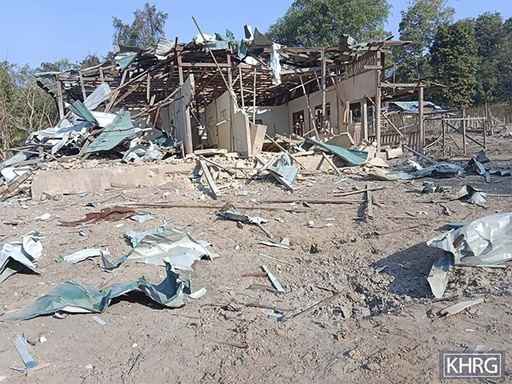
BANGKOK — A newly released report reveals that Myanmar’s military has persistently targeted civilians as a strategy of collective punishment in the southeastern region of the country since it took control in early 2021. The findings were presented by the Karen Human Rights Group, which highlighted the troubling use of airstrikes against villages, a situation that reflects a broader trend of violence against non-combatants throughout the war-torn nation. James Rodehaver, who leads the Myanmar team at the U.N.’s Office of the High Commissioner for Human Rights, discussed these findings during an online panel held to coincide with the report’s release.
While military officials have not yet responded to the report, they have previously asserted that their strikes target only legitimate military objectives, labeling opposing forces as terrorists. Since the military coup that ousted the democratically elected government of Aung San Suu Kyi in February 2021, Myanmar has been engulfed in conflict. The military’s harsh crackdown on peaceful protests led to widespread armed resistance, pushing the military to increasingly resort to airstrikes in an attempt to regain control of contested territories.
The military finds itself on the backfoot, facing opposition from various ethnic militias and a multitude of armed guerrilla groups known collectively as the People’s Defense Forces, all of which are committed to restoring democratic governance in the country. Human rights organizations and international investigators have uncovered alarming evidence that security forces randomly and unjustifiably target civilians, leading to bombings, mass killings of detained individuals, and extensive destruction of homes.
Reports from the Assistance Association for Political Prisoners indicate that at least 540 individuals, including 109 children, have died due to military airstrikes between January and October of this year. The Karen Human Rights Group documented 227 airstrikes that specifically targeted villages, schools, and medical facilities in seven southeastern districts where Karen guerrilla fighters are in active combat with the military. Areas included in their report range from neighboring regions of Bago to southern Mon state and Tanintharyi.
The findings from the KHRG were derived from interviews with 22 local villagers, including six village leaders who either experienced or witnessed the airstrikes firsthand. Additional insights came from local civil society organizations and non-governmental groups contributing to humanitarian efforts in the region. This data was consolidated from reports and evidence collected over the preceding three years.
The KHRG’s investigation revealed a disturbing tally of at least 417 civilian casualties due to the 227 airstrikes, which resulted in 168 deaths and 249 injuries among civilians. In contrast, the report indicated that only 22 non-civilians were killed or harmed in the airstrikes.
The damage was extensive; the report noted that in addition to civilian residences, at least 67 religious structures, 42 schools, and 14 medical facilities were either destroyed or heavily damaged as a result of military operations. The ruling junta, known as the State Administration Council, employs various irregular methods of conducting airstrikes, ranging from targeted bombings of specific community buildings to widespread bombardments affecting multiple villages and farmlands.
International law prohibits direct attacks on civilians or civilian property, defining such acts as war crimes and potentially qualifying them as crimes against humanity. The report also emphasized that the military has shown a troubling inability to differentiate between armed resistance fighters and local villagers. In many instances, airstrikes seem to function as collective punishment for local resistance activities.
Moreover, the KHRG stated that the military frequently failed to provide warnings or implement precautions aimed at reducing civilian casualties across nearly all reported incidents. Rodehaver of the U.N. Office for the Coordination of Humanitarian Affairs noted that the military routinely retaliates against civilian populations whenever its forces face significant setbacks on the battlefield.
